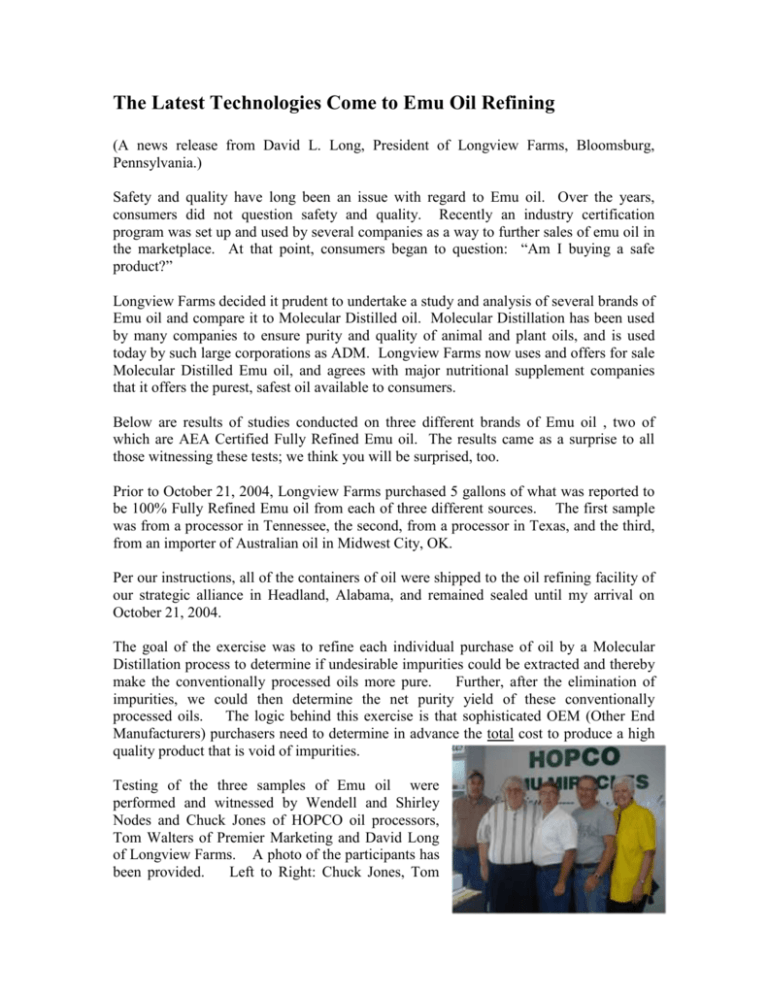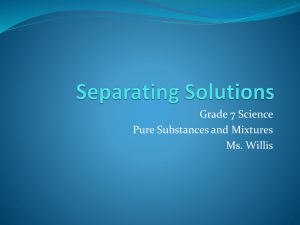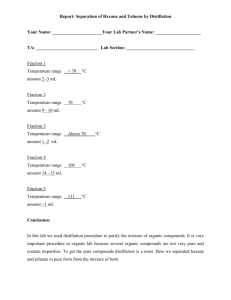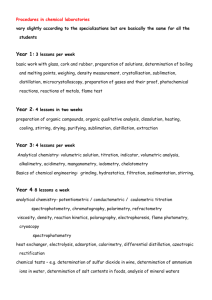
The Latest Technologies Come to Emu Oil Refining
(A news release from David L. Long, President of Longview Farms, Bloomsburg,
Pennsylvania.)
Safety and quality have long been an issue with regard to Emu oil. Over the years,
consumers did not question safety and quality. Recently an industry certification
program was set up and used by several companies as a way to further sales of emu oil in
the marketplace. At that point, consumers began to question: “Am I buying a safe
product?”
Longview Farms decided it prudent to undertake a study and analysis of several brands of
Emu oil and compare it to Molecular Distilled oil. Molecular Distillation has been used
by many companies to ensure purity and quality of animal and plant oils, and is used
today by such large corporations as ADM. Longview Farms now uses and offers for sale
Molecular Distilled Emu oil, and agrees with major nutritional supplement companies
that it offers the purest, safest oil available to consumers.
Below are results of studies conducted on three different brands of Emu oil , two of
which are AEA Certified Fully Refined Emu oil. The results came as a surprise to all
those witnessing these tests; we think you will be surprised, too.
Prior to October 21, 2004, Longview Farms purchased 5 gallons of what was reported to
be 100% Fully Refined Emu oil from each of three different sources. The first sample
was from a processor in Tennessee, the second, from a processor in Texas, and the third,
from an importer of Australian oil in Midwest City, OK.
Per our instructions, all of the containers of oil were shipped to the oil refining facility of
our strategic alliance in Headland, Alabama, and remained sealed until my arrival on
October 21, 2004.
The goal of the exercise was to refine each individual purchase of oil by a Molecular
Distillation process to determine if undesirable impurities could be extracted and thereby
make the conventionally processed oils more pure.
Further, after the elimination of
impurities, we could then determine the net purity yield of these conventionally
processed oils. The logic behind this exercise is that sophisticated OEM (Other End
Manufacturers) purchasers need to determine in advance the total cost to produce a high
quality product that is void of impurities.
Testing of the three samples of Emu oil were
performed and witnessed by Wendell and Shirley
Nodes and Chuck Jones of HOPCO oil processors,
Tom Walters of Premier Marketing and David Long
of Longview Farms. A photo of the participants has
been provided.
Left to Right: Chuck Jones, Tom
Walters (now deceased), David Long, Wendell Nodes, Shirley Nodes.
Test ONE:
The first test was conducted on the oil from Tennessee. The purchase of this oil was
made on October 1, 2004 and was shipped via UPS shortly thereafter.
This oil was
represented as being “AEA Certified Fully Refined Oil” and was provided in a 5 gallon
pail.
In contrast to the AEA stated program guidelines, this oil container and label did not bear
a lot or batch number. The label did have the AEA program Logo, but there was no
indication that the oil in the container was “AEA Certified”.
The container’s
removable lid had a hand written “sharpie” marker notation that read “Batch #109024".
A piece of paper was found in the pail’s shipping carton that appeared to be an
“Analytical Report” of information “Submitted by: (supplier of oil)”.
The paper did not indicate the date of manufacture of the oil. It also did not indicate if
a “Certificate of Analysis” had been performed by an AOCS Accredited Chemist at an
Accredited Laboratory.
And, there was no indication or description of persons or
facilities involved with the “chain of possession” of the oil from time of manufacture
through date of shipment (October 1, 2004).
Subsequent to purchasing the oil, David Long contacted the processor and requested an
AEA program approved “Certificate of Analysis”. Although the AEA’s website states
that the document will be provided to the “products company”(in this case Longview
Farms), the Tennessee processor has refused the request.
When the container lid of the Test ONE oil was removed, it was observed by all that:
1.
A human body hair was floating on the surface, and what were believed to be emu
feather particles were seen within the oil.
2.
4 Unidentified Floating Objects (UFO’s) were floating on the surface.
3.
5 puddles of a yellow translucent liquid compound were floating on the surface.
(Each about the size of a 25 cent piece).
4.
The oil was light yellow in color (nearly white).
5.
The oil exhibited a very slight oil odor.
6.
The oil had a thick creamy consistency.
7.
There were no apparent separations of the fatty acids.
8.
The oil did not readily penetrate human skin.
9.
The net weight contents of the pail, prior to distillation was 39 lbs - 1.5 oz.
10.
The per gallon net weight was approximately 7.82 pounds.
As a notation to item 3.; The oil processor states that his oil does not separate. Further,
the substance found was not relative to a separation of fatty acids. The compound was
significantly a darker color of yellow to that of the oil and clearly was something foreign
to emu oil The substance was most likely an odor masking agent or preservative.
A six fluid ounce sample was taken of the Test ONE oil prior (pre) to the Molecular
Distillation process and was sent to an AOCS Accredited Laboratory for technical
analysis. Per the attached photo this sample is designated BIN-PRE.
The Test ONE oil was heated to an appropriate temperature and then run through the
Molecular Distillation process. The process cannot remove essential and non essential
fatty acids.
The process can only remove unwanted free fatty acids, contaminants,
UFO’s, odor masking agents, preservatives and moisture.
Typically the removal of
these impurities are trapped within discharge points of the still or they are vented to the
exterior of the facility. The distilled oil’s loss of these impurities is measured in weight
by the reduction in net weights between “prior” and “post”
distillation.
No finished refined oil remains within the
distillation equipment.
A six fluid ounce sample was taken of the Test ONE oil after
(post) the Molecular Distillation process and was also sent to
an AOCS Accredited Laboratory for technical analysis. Per
the attached photo this sample is designated BIN-POST.
The net weight contents of the pail after (post) the distillation
process was 35 lbs. - 2.1 oz.
The per gallon net weight after distillation was
approximately 7.03 pounds. This net loss of 3.96 lbs. of the 5 gallon sample is directly
attributable to the removal of unwanted free fatty acids, contaminants, UFO’s, odor
masking agents, preservatives and moisture. For a pictorial
view of some of these removed impurities, please see the
photo of a jar containing BIN-RESIDUE.
In the case of
Test ONE, after elimination of the impurities, the post
molecular distillation yield was equal to 90% of the net
original weight. Molecular Distillation removed impurities
from the Test ONE sample that computed to 10% of its
original net weight.
OEM purchasers seeking the purest possible emu oil must consider this yield reduction
factor when purchasing a product that has not been Molecular Distilled.
Test TWO:
The second test was conducted on the oil from Texas.
The purchase of this oil was
made on September 23, 2004 and was shipped via UPS the following day. This oil was
represented as being “AEA Certified Fully Refined Oil” and was provided in a 5 gallon
pail.
In contrast to the AEA stated program guidelines, this oil container and label did not bear
a lot or batch number and the container label did not contain the AEA program Logo.
The container’s removable lid had an AEA program Logo and a hand written “sharpie”
marker notation that read “40302173". No paperwork was shipped with the oil.
David Long requested the processor provide him with the AEA program allowable
“Certificate of Analysis”(COA). The processor immediately upon request supplied a
copy of same. The COA did not specify the date of manufacturer but it did stipulate the
date of Certification.
When the container lid of the Test TWO oil was removed, it was observed by all that:
1.
3 Unidentified Floating Objects (UFO’s) were floating on the surface.
2.
6 puddles of a yellow translucent liquid compound were floating on the surface.
(Each about the size of a 25 cent piece)
3.
The oil was light yellow in color.
4.
The oil exhibited a slight oil odor.
5.
The oil had a thin creamy consistency.
6.
There were no apparent separations of the fatty acids.
7.
The oil does readily penetrated human skin.
8.
The net weight contents of the pail, prior to distillation was 38 lbs. - 14.5 oz.
9.
The per gallon net weight was approximately 7.78 pounds.
As a notation to item 2.; The substance found was not
relative to a separation of fatty acids.
The compound
was significantly a darker color of yellow to that of the
oil and was clearly something foreign to emu oil. The
substance was most likely an odor masking agent or
preservative.
As in the case of Test ONE, a six fluid ounce sample was
taken of the Test TWO oil prior (pre) to the Molecular
Distillation process and was sent to an AOCS Accredited Laboratory for technical
analysis. Per the attached photo this sample is designated EPIC-PRE.
As in the case of Test One, the Test TWO oil was heated to an appropriate temperature
and then run through the Molecular Distillation process.
Again, all functions of the
distillation effect the removal of unwanted impurities. None of the essential and non
essential fatty acids are removed.
As in the case of Test ONE, a six fluid ounce sample was taken of the Test TWO oil after
(post) the Molecular Distillation process and was also sent to an AOCS Accredited
Laboratory for technical analysis.
Per the attached photo this sample is designated
EPIC-POST.
The net weight contents of the pail after (post) the distillation process was 37 lbs. - 11.5
oz. The per gallon net weight after distillation was approximately 7.54 lbs. In the case
of Test TWO, after elimination of the impurities, the post molecular distillation yield was
equal to 97% of the net original weight. Molecular Distillation removed impurities from
the Test TWO sample that computed to 3% of its original net weight.
Again, for a
pictorial view of some of the removed impurities,
please see the photo of a jar containing EPICRESIDUE.
Test THREE:
The third test was conducted on the oil purchased from a company located in Midwest
City, OK, that imports Australian Emu oil.
The purchase of this oil was made on
September 24, 2004 and was shipped via UPS the following day. This oil, which was
provided in 5- 1 gallon jugs was not represented as being “AEA Certified Fully Refined
Oil”
The supplier of the oil did not provide a “Certificate of Analysis” and no lot or batch
numbers appeared on any of the containers.
When the Test THREE jugs were emptied into a heating vat, it was observed by all that:
1.
A large number of Unidentified Floating Objects were present.
2.
The oil was a medium yellow in color.
3.
There were some pale red blotches of a substance found throughout the oil.
4.
The Oil exhibited an offensive oil odor, and
5.
An additional fragrance indicated the oil had been over heated (scorched).
6.
The oil had a thin creamy, yet gritty, consistency.
7.
There were no apparent separations of the fatty acids.
8.
The oil does readily penetrate human skin.
9. A significant amount of what appeared to be unfiltered “absorbing clay” was
found.
10. There were two pieces of tan colored plastic particles contained in this oil.
11.
The net weight contents of the jugs, prior to distillation was 39 lbs - 2.8 oz.
12.
The per gallon net weight was approximately 7.84 pounds.
As a notation to item 3.; The pale red blotches intensified in color and concentrated
themselves as a component of the eliminated residue. Most likely this is un-removed
blood protein particulate. See the photo of a jar containing AUS-RESIDUE.
As in the case of Test ONE and Test TWO, a six fluid ounce sample was taken of the
Test THREE oil prior (pre) to the Molecular Distillation process and was sent to the
laboratory. Per the attached photo this sample is designated AUS-PRE.
As in the cases of Test ONE and Test TWO, the Test THREE oil was heated to an
appropriate temperature and then run through the Molecular Distillation process. Again,
all functions of the distillation effect the removal of unwanted impurities. None of the
essential or nonessential fatty acids are removed.
As in Test ONE and Test TWO, a six ounce
sample was taken of Test THREE oil after
(post) the Molecular Distillation process and
was sent to the laboratory. Per the attached
photo this sample is designated AUS-POST.
The net weight contents of the jugs after (post)
the distillation process was 36 lbs. - 3.5 oz.
The per gallon net weight after distillation was
approximately 7.24 lbs. In the case of Test
THREE, after elimination of the impurities, the post
molecular distillation yield was equal to 92% of the
net original weight. Molecular Distillation removed
impurities from the Test THREE sample that
computed to 8% of its original net weight. Again,
for a pictorial view of some of the removed
impurities, please see the photo of a jar containing
AUS-RESIDUE.
Test No.
1 – BIN
2 – EP
3 – AUS
Pre Wgt./Gal
7.82 lbs.
7.78
7.84
Post Wgt./Gal
7.03 lbs.
7.54
7.24
Loss %
10%
3%
8%
Yield %
90%
97%
92%
As pointed out, the first and second tests involved emu oil that used to be considered the
best (and purest) that our industry had to offer (AEA Certified).
These experiments
were made to determine if significant amounts of impurities could be removed from emu
oil that has been “conventionally” refined, and they were removed. We also needed to
determine the costs involved. This further purifying process (Molecular Distillation) is
essential if we ever hope to take emu oil beyond skin moisturizing. There is a market
for emu oil that does not contain impurities, we just have to prove to our critics that we
are capable of producing it. We now have the means to prove it. If you could witness
first hand the RESIDUE, impurities and stench that we have extracted from these tests,
you could understand why some critics have been reluctant to allow emu oil into the
medical society. The technology of the Molecular Still now gives us the credibility that
we so desperately need.
For further information regarding this article and Longview Farms brand Molecular
Distilled Emu oil, contact David Long at 570-380-1077.
##########
This information cannot be copied or published without written permission from the author. Copy right
2004. David Long All Rights Reserved.







